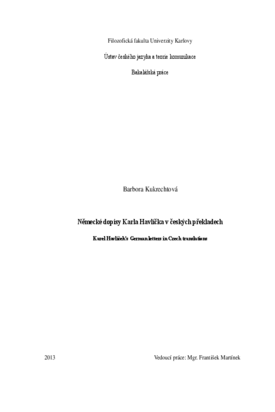Německé dopisy Karla Havlíčka v českých překladech
Karel Havlíček's German letters in Czech translations
bakalářská práce (OBHÁJENO)

Zobrazit/
Trvalý odkaz
http://hdl.handle.net/20.500.11956/56025Identifikátory
SIS: 124276
Kolekce
- Kvalifikační práce [23715]
Autor
Vedoucí práce
Oponent práce
Mareš, Petr
Fakulta / součást
Filozofická fakulta
Obor
Český jazyk a literatura - Německý jazyk a literatura
Katedra / ústav / klinika
Ústav českého jazyka a teorie komunikace
Datum obhajoby
9. 9. 2013
Nakladatel
Univerzita Karlova, Filozofická fakultaJazyk
Čeština
Známka
Výborně
Klíčová slova (česky)
Karel Havlíček, korespondence, editologie, němčina, překlad, český purismusKlíčová slova (anglicky)
Karel Havlíček, correspondence, textology, German language, translation, Czech purismV této bakalářská práci jsou analyzovány české překlady německých dopisů Karla Havlíčka pořízené Ladislavem Quisem (1903) a Miloslavem Novotným (1941) a úpravy provedené v Novotného překladech Jaroslavou Janáčkovou (1995). V úvodu je načrtnuta současná situace týkající se vydávání Havlíčkovy korespondence. Po úvodu je zařazen stručný popis stavu českého jazyka v době vzniku Havlíčkových českých dopisů. Vlastní analýza se zaměřuje především na možné ovlivnění překladů jazykem originálu a snahu se tomuto ovlivňování vyhýbat, v teoretických částech jednotlivých kapitol jsou proto osvětlovány některé pojmy z německé gramatiky. Jazykové prostředky použité jednotlivými překladateli jsou dále srovnávány s prostředky běžnými v době vzniku překladů a v Havlíčkových českých dopisech s cílem určit, do jaké míry se v příslušných překladech projevuje tendence jazyk archaizovat nebo naopak modernizovat. Získaná data slouží jako podklad pro určení dojmu identičnosti pisatele v českých dopisech a překladech z němčiny.
This thesis analyzes the Czech translations of Karel Havlíček's German letters carried out by Ladislav Quis (1903) and Miroslav Novotný (1941), and the revisions made by Jaroslava Janáčková (1995) in Novotný's translation. In the introduction, the present-day situation concerning the publication of Havlíček's correspondence is outlined. A brief description of the state of the Czech language at the time of creation of Havlíček's Czech letters followes the introduction. The analysis itself focuses especially on the possible influence of the original language on the translations and the tendency to avoid such influence. Therefore, in the theoretical parts of individual chapters, some terminology regarding German grammar is explained. Language resources used by individual translators are also compared with the means common at the time of translation and in Havlíček's Czech letters to determine the extent to which the respective translations display tendency to archaize or modernize the language. The obtained data serve as a basis for determining the impression of identicity of the writer in the Czech letters and in the translations from German.
